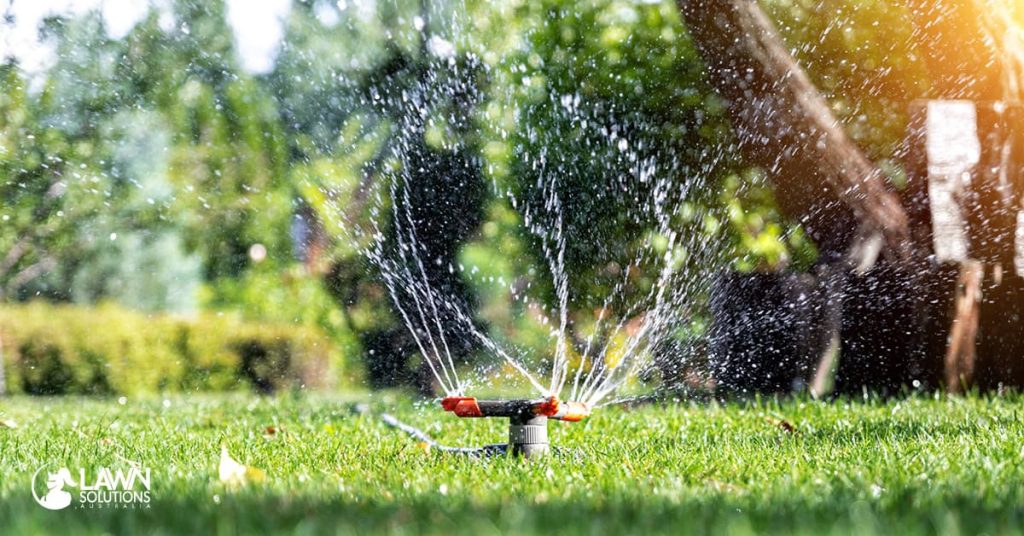Sir Walter Buffalo Maintenance
Like all other turf varieties, genuine Sir Walter DNA Certified lawns also requires specific care to keep them vibrant and healthy. Keep reading to discover essential techniques and our top tips for mowing, watering, fertilising, weed control, pest/disease prevention and more.
Regular Lawn Maintenance
Mowing
To maintain a lush Sir Walter Buffalo lawn, it’s crucial to follow proper mowing techniques.
Regular mowing is recommended, especially during the active growing season, to prevent grass growth and to encourage a dense growth pattern. During peak growing season, you may need to mow your Sir Walter lawn every 2-3 weeks. However, at other times, the most you’ll need to mow is once a month.
The ideal height for your Sir Walter Buffalo lawn is around 25-40mm. This will be an ideal balance between aesthetics and health. However, in shady areas, you may wish to keep it slightly longer.
Top tip: Avoid cutting more than one-third of the grass height at a time to prevent stress and scalping.

Fertilising and Soil Enrichment
To keep your Sir Walter grass healthy long term, proper fertilisation and soil enrichment are crucial. While Sir Walter DNA Certified grass requires less fertiliser than other grass varieties, seasonal fertiliser will help to enrich your soil and keep your lawn growing well throughout the year.
Choose a fertiliser specifically designed for Buffalo grass with a nitrogen-phosphorus-potassium (N-P-K) ratio suitable for your lawn’s needs.
Top tip: A slow-release fertiliser with pre-emergent like Oxafert should be applied in late Autumn as this will keep your Sir Walter lawn greener through Winter and keep the weeds at bay.
Watering
As your Sir Walter Buffalo lawn is naturally drought tolerant, infrequent, deep watering is important to maintain a deep root system. Watering too frequently or not deeply enough will mean the roots have no reason to grow deep into the soil as they receive more than enough water at the surface.
While too frequent watering can lead to shallow root growth and create favourable conditions for disease and weed growth, underwatering can stress the grass and give you a brown lawn.
As a general rule, water the lawn thoroughly and deeply when the soil dries out. In hotter months, more frequent watering may be necessary, while in cooler months, less frequent watering is typically required.
Top tip: Water in the morning or afternoon to avoid high amounts of water evaporation in the heat of the day, or damp grass (and risk of disease) in the evening.

Weed & Pest Lawn Care
Weed Control
Some common weeds that can threaten Sir Walter Buffalo grass include Bindi, clover, dandelions, and creeping oxalis. While you can wait until you recognise these weeds and treat them accordingly, we recommend preventative measures.
Preventative measures include regular lawn maintenance as well as pre-emergent herbicides such as Oxafert.
For existing weeds, use selective herbicides specifically designed for Buffalo grass to target the weeds while sparing the turf.
Top tip: Always check herbicide labels to ensure they are suitable for buffalo grass varieties as some herbicides will target broadleaf lawn varieties as well as weeds.
Pest control
Some common pests that affect Sir Walter Buffalo grass include armyworms, webworms, and nematodes. Diseases such as brown patches and dollar spots can also pose threats. Learning to identify these potential threats helps you address the issue as soon as possible.
Proper irrigation practices and maintaining good soil health prevent pest infestations and disease outbreaks. Avoid overwatering, as it creates favourable conditions for pests and diseases.
However, regularly inspecting your lawn for signs of pest infestations or disease symptoms will mean you increase the chances of successful treatment and minimise potential damage to your Sir Walter turf.
Depending on the specific pest or disease, various treatment options are available. Pesticides or fungicides may be necessary to be able to fully treat pest issues.

Annual Lawn Care
Lawn Aeration
If your soil is compacted, you may need to aerate it to allow your Sir Walter lawn to continue to receive water and grow. To easily aerate your lawn, you can use a pair of aeration sandals or your garden fork.
However, if you have a larger lawn, a coring machine may be a better option. Aerating will not just improve the health of your soil. It will also improve airflow and nutrient contents which will help strengthen your grass’s roots.
Top tip: If you’re not sure if you need to aerate your lawn, plunge a long screwdriver into your soil in a few places. If it easily goes 100-150mm deep, then your soil is fine. If not, you need to aerate you lawn.
Testing your soil
Conducting a soil test helps identify nutrient deficiencies and imbalances, enabling you to adjust how you fertilise to ensure your lawn has everything it needs. Sir Walter Buffalo grass thrives in slightly acidic to neutral soil with a pH range of 6.0-7.0.
Balancing the soil pH contributes to optimum growth and nutrient absorption.

Discover more about Sir Walter lawns
Sir Walter Buffalo Characteristics
Sir Walter Buffalo Maintenance
Sir Walter Buffalo Uses

Sir Walter DNA Certified

Sir Grange Zoysia

Nullarbor Couch

Eureka Kikuyu

Our Turf
TifTuf Bermuda
Buy Turf Online © 2019 All Rights Reserved. | Proudly Designed and Developed by Sydney ICT

